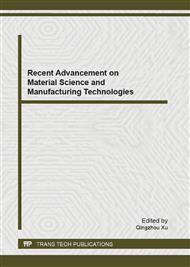[1]
W.Perruquetti and J.P. Barbot:Sliding mode control in engineering:Marce DekkeVol.35(2005)No.1,p.102.
Google Scholar
[2]
W.B. Gao: Variable Structure Control Theory And Design Method (Science Press, China 1996).
Google Scholar
[3]
F.X. Wang: Sliding Mode Variable Structure Control (Mechanical Industry Press, China 2001).
Google Scholar
[4]
Y.l.Shu and Z.Y. Kong: Adaptive SlidingMode Variable Structure Control for a New Hyper Chaos System: Journa l of Chongqing University of Techno logy( Natural Science), Vol.24(2010) No.11,p.109.
Google Scholar
[5]
X.Chen:Adaptive sliding mode control for discrete-time mult-i input mult-i output systems:Automatica,Vol.42(2006)No.1,p.427.
DOI: 10.1016/j.automatica.2005.10.008
Google Scholar
[6]
J.K. Liu:MATLAB Simulation For Sliding Mode Control (Tsinghua University Press, China 2005).
Google Scholar
[7]
J.K. Liu and F.C. Sun: Research and development on theory and algorithms of sliding mode control: Control Theory & Applications, Vol. 24(2007)No. 3,p.407.
Google Scholar
[8]
F.J. Lin and S.L. Chiu. Adaptive fuzzy sliding-mode control for PM synchronous servo motor drives: IEE Proc.-Control Theory Appl., Vol. 145(1998) No. 1 ,p.63.
DOI: 10.1049/ip-cta:19981683
Google Scholar
[9]
Q. P. Ha, Q. H. Nguyen, D. C. Rye and H. F. Durrant-Whyte. Fuzzy sliding-mode controllers with applications:IEEE Tran Industrial Electronics,Vol.48(2001)No.1,p.38.
DOI: 10.1109/41.904548
Google Scholar
[10]
L.H. UetaL:Analys is and design of l/O base dvariab Iestruet ureadaptive control:IEEE Trans Auto Control. Vol.39 (1994)No.1,p.4.
Google Scholar
[11]
L.S. Bocca. Adaptive-control of Chaos:Europhysics Letters,Vol.31(1995)No.1,p.127.
Google Scholar
[12]
T.Li and Y.Feng and C.Q.An:Chattering Free Method Using Fixed Boundary in VSS:CONT ROL AND DECISION,Vol.15(2000) No.6,p.645.
Google Scholar
[13]
R.J. Wai C.M. Lin and C.F. Hsu:Adaptive fuzzy sliding-mode control for electrical servo drive:Fuzzy Sets and Systems,Vol.143(2004)No.2,p.295 .
DOI: 10.1016/s0165-0114(03)00199-4
Google Scholar
[14]
S.Labiod M.S. Boucherit and T.M. Guerr:Adaptive fuzzy control of a class of MIMO nonlinear systems:Fuzzy Sets and Systems, Vol.151(2005)No.1,p.59.
DOI: 10.1016/j.fss.2004.10.009
Google Scholar
[15]
D.Krupp and Y.B. Shtessel:Chattering-free sliding mode control with unmodeled dynamics San (Diego,American ,1999).Vol.6,p.530 .
Google Scholar
[16]
J.X. Xu,Y.J. Pan and T.H. Lee:A gain scheduled sliding mode control scheme using filtering techniques with applications to multi-link robotic manipulators(Turin, Italy, November 8-10, 2000).Vol.122,p.641.
DOI: 10.1115/1.1318352
Google Scholar
[17]
P.Yang and Z.K. Zhang: Chatter control in sliding variable structure control systems:J Tsinghua Univ (Sci &Tech),Vol.45(2005),No.1,p.93.
Google Scholar
[18]
J.J. Lee and Y.S.Xu:A new method of switching surface design for multivariable variable structure systems:IEEE Trans,Automatic Control,Vol.39(1994)No.2,p.414.
DOI: 10.1109/9.272347
Google Scholar


